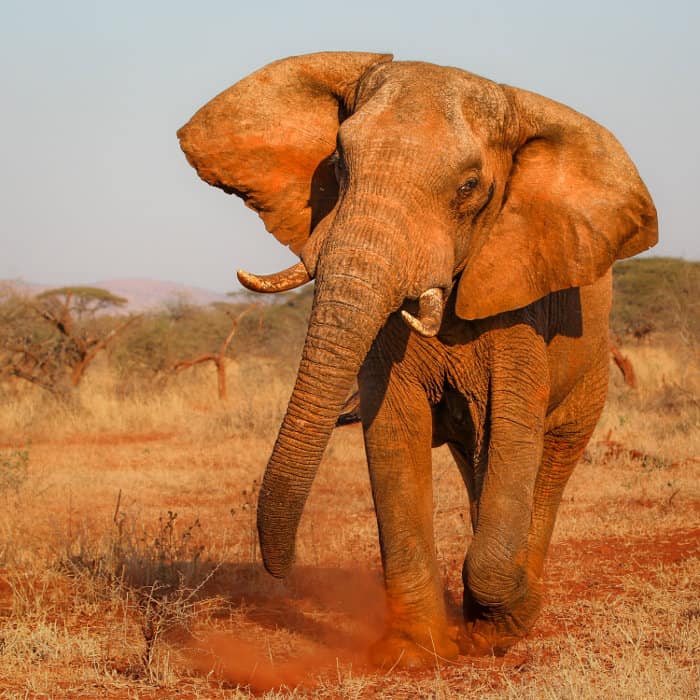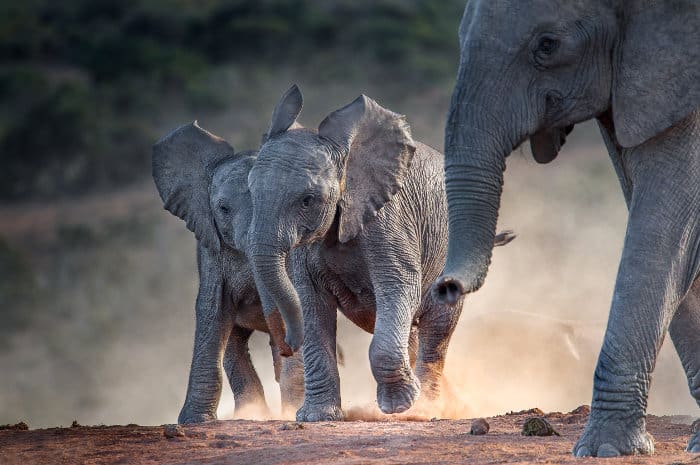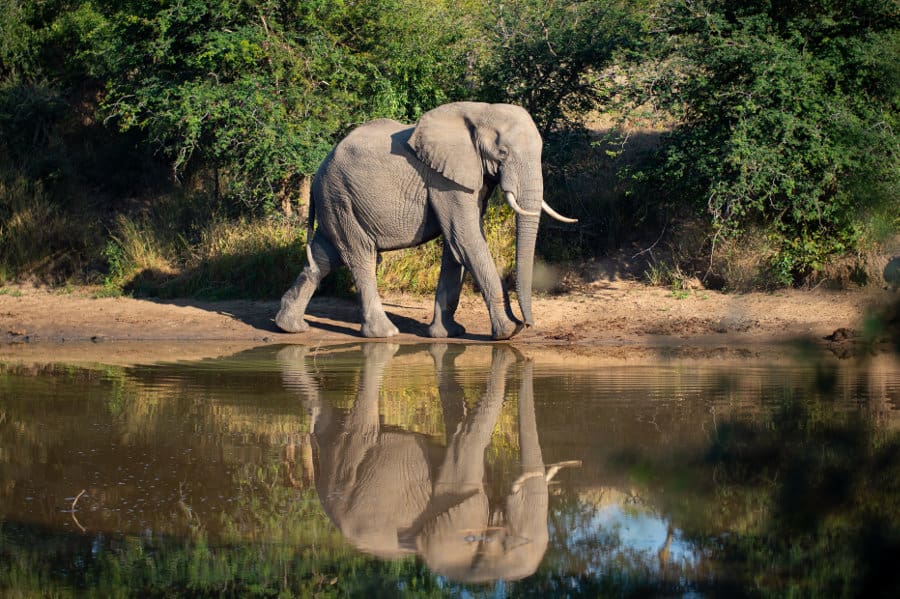African elephants can run at speeds of up to 40 km/h (25 mph), although most African elephants are more likely to have a top speed of 25 kph (around 15 mph).
However, that’s just one part of the story. When elephants are at top speed there is always one of their feet on the ground, so technically they don’t run at all. And what do you do when an elephant is running at you?
This article explores the beautiful African elephant on the move and provides some practical advice on what to do when encountering one in the wild.
How Fast Can an Elephant Run?

According to a recent study published in Nature magazine, Asian elephants run at 25 km/h (15 mph).
African elephants are much larger and can run at 40 km/h (25 mph), although no definitive studies have been conducted.
A team of biomechanists used kinetic measurements to measures speed of Asian elephants in Thailand.
They recorded 188 trials of captive elephants walking and running along a 30-meter course.
Then they came up with 25 km/h, but acknowledged that some of the elephants studied actually ran faster.
Most information about African elephants is heresy, based on reports from the bush and researchers on safari.
Unlike their Asian counterparts, African elephants have never been tamed, so it has been impossible to conduct a scientific study to measure their speed.
They move fast over short distances, especially when threatened. Most estimates for an elephant’s speed are between 20-40 km/h.
Anyone who has seen an elephant running in the wild is likely to think that elephants run closer to 40 km/h than 20.
How Long Can Elephants Run for?
Elephants are the world’s largest land mammals. They’re the largest animal to be walking (and running) on the earth right now.
A mature male African elephant can weigh over six tons. Some measure seven tons – that’s 7000 kg or 15,000 pounds.
It is very difficult for elephants to run at top speed for long, due to their immense weight. Usually they only sprint for less than 50 meters and can only maintain a slow running pace for less than a mile.
Wild African elephants are always on the move. Most of them will cover at least 25 kilometers every single day. Some have been tracked and known to traverse almost 200 kilometers in a single day.
Do Elephants Run, or Do They Just Walk Very Fast?

Running usually involves all your feet coming off the ground. But that never happens with these giant pachyderms.
Compare them to other four-legged mammals and there’s another interesting quirk.
Most animals with four legs will walk slowly, then trot at an increased speed, before galloping in order to run fast. Just think about a wildebeest or buffalo.
Antelope like springbok are different, as they have a two-footed hopping style, but it’s the same concept – a clear distinction in how they move dependent on the speed.
Almost all quadrupeds place their feet differently dependent on the speed they want to go. Just think about the footfall pattern of a horse.
Elephants don’t.
They always maintain the same footfall pattern – right hind foot, right front foot, left hind foot, left front foot. So you could say that elephants are not running, just walking very fast.
Nobody is sure but the general consensus is that elephants are too heavy to bring all their feet off the ground. Just imagine the force and pressure on the joints, 6 tons of elephant coming down with every step!
It gets more complicated!
However, there are animals that run without their feet leaving the ground. Many ground birds do this, such as ducks.
The scientific, biomechanical definition for running concerns whether there is a change in style.
When we walk we swing our legs back and forth in a straight line, something known as a pendulum-like gait.
When we run we bounce (although not very high now I’m getting older!), with the muscles in our leg compressing before expanding with power like a spring – a bouncing gait.
Some researchers think that elephants change from a walking gait to a bouncing gait, so they do run. Others think not. Nobody is for sure.
One of the reasons I love elephants so much is that even though they are so big, they are actually pretty mysterious. They haven’t been tamed so maybe we will never know if an African elephant can run.
Could You Outrun an Elephant?
That’s very unlikely. Elephants can reach 40 km/h but even well trained athletes rarely make it past 25 km/h. I can’t run that fast and I’ve seen an elephant run – the chance of outrunning one must be one in a thousand.
Because they are so big it’s hard to outrun an elephant by zigzagging. You would need to make ten steps for every one of the elephant’s, so there is no way it’s possible.
Understand: What You Should Do When Encountering an Elephant in the Wild

Respect their size and beauty
Instead of training to outrun an elephant, learn how to acknowledge their behaviour so you never need to run away from one!
These enormous animals are usually pretty docile. You could call them big friendly giants.
That’s as long as they are happy – when their mood changes they become dangerous.
Rule #1 – Always give an elephant space. They don’t like to be challenged.
Rule #2 – Don’t make sudden loud noises, such as hand-claps or excited shrieks.
Rule #3 – Never use the flash on your camera. This is a certain way to have your safari vehicle flipped.
Rule #4 – Don’t come close to them on foot unless you are with a very experienced guide.
Rule #5 – If an elephant runs at you, the safest place to be is behind a tree.
Understand their behaviour
Leopards are incredibly dangerous because you never know what they are thinking. Fortunately, elephants like to show how they feel.
Flapping their ears is a way for elephants to cool down. It’s normal for the ears to flap slowly, every once in a while.
Flapping their ears repeatedly and at speed is a way for elephants to showcase their size. It’s a sign of dominance.
The other telltale sign is feet stamping. Usually the front feet come off the ground and kick up a load of dust when they come down.
So remember, ear flapping plus feet stamping means the elephant is not in a good mood and could be very dangerous.
Elephants are clever and will direct their behaviour towards a target. In most cases that’s another elephant, or another wild animal.
For example, elephants will use this tactic to scare away a rival, a pride of lions, or a herd of buffalo drinking from their waterhole.
If an elephant is stamping its feet and flapping its ears, while looking straight at you and the safari vehicle…then you must back away immediately.
Retreat immediately

I have never understood how so many tourists have had dangerous encounters with elephants. Their behaviour is one of the easiest to understand of all Africa’s mammals.
Stamping feet and flapping ears in your direction – that’s a warning.
Stamping feet and flapping ears in your direction – that’s a second warning.
Stamping feet and flapping ears in your direction – the elephant is about to charge.
These majestic animals actually give you two warnings – lions certainly don’t do that.
However, some tourists think this behaviour is part of a dramatic show for their camera, so they keep taking the flash photos.
Until the elephant has flipped the vehicle and sent it rolling across the Kruger savannah.
So the golden rule with elephants is to retreat when you experience the first warning. That way you won’t need to find out if you can outrun an elephant.
What Animals are Faster Than Elephants?

Of course the big cats are faster than elephants.
Lions can reach 80 km/h over short bursts, leopards 60 km/h but can maintain that speed for longer, while cheetah are the fastest mammals on earth with a top speed of 120 km/h.
The critically endangered wild dog can maintain a speed of 40 km/h for five kilometers.
But how does the elephant compare against the other giants of the savannah?
Hippo – top speed is 30 km/h and this giant kills more people than any other African mammal.
Black rhino – a top speed of 55 km/h but mostly seen trotting at around 30 km/h.
Cape buffalo – weighing up to a ton and running at 57 km/h, buffalo are not to be messed with.
Giraffe – giraffe have a beautiful loping gait and can run at 60 km/h when they get going.
Learn More About Africa’s Elephants
Encountering an elephant is one of safari’s great treats. And it’s never usually just one. Often it’s a herd and sometimes you see hundreds of them.
Chobe National Park in Botswana is home to the world’s largest elephant population, with some researchers believing that over 100 000 are based there during the dry season.
You can read more about the best places to watch elephants in Africa here.
What happens when a young elephant takes on a pride of lions? Find out below!
Also check out what sound an elephant makes. And if you want to encounter an elephant, take a look through our practical guide to planning an African safari.




In story about speed of African elephants there is a short comment that most information is – heresy.
Heresy is when one religious group views comments they view as wrong or aggravating about their religion. Considered HERESY.
Word you were looking for is: – HEARSAY – anecdotal unsubstantiated information.